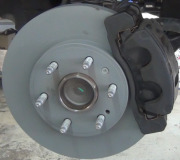Start with the basics. First of all, does the parking brake work? Check for a sticking cable by looking at each rear cable where it comes out of the casing. If you see about the first half inch that's shiny, that indicates it's not getting pulled all the way back in. If you flex the casing by hand sometimes a sluggish cable will go back in.
Next you'll have to pull the drum off and look at the shoes. The one toward the front must have the shorter lining. A lot of people mistakenly put the longer lining toward the front and that will cause easy wheel lockup.
Now look at where the two shoes touch the large anchor pin on the top. Both shoes must be solidly against that pin. If one is not, and you push on it and pushes the other shoe away, the parking brake is partially applied or the cable is stuck in the applied position. You'll see the parking brake lever is pulled forward out of behind the rear shoe. Use a pry bar to fully retract that lever. That will pull the parking brake cable back. If doing that causes the left cable to be pulled forward, the main cable is adjusted too tightly.
Another way to identify a tight or sticking cable is to push on the parking brake strut bar between the two shoes, right above the axle. There must be a good 1/8th inch of movement when you push it against the anti-rattle spring. If that bar is tight it will hold the shoes out and prevent one or both of them from resting on that anchor pin on top. That will cause real easy wheel lockup.
Also look for signs of a leaking axle seal. If any gear lube gets on the friction surfaces the shoes will have to be replaced and the drum must be cleaned and machined.
Anti-lock brakes didn't exist in the '70s. As with most other useful innovations, Chrysler had the first anti-lock brake system for cars in 1969 but it didn't do any more than what a driver could do with his foot. The modern systems first appears in the late '80s.
Saturday, August 31st, 2013 AT 12:02 PM



